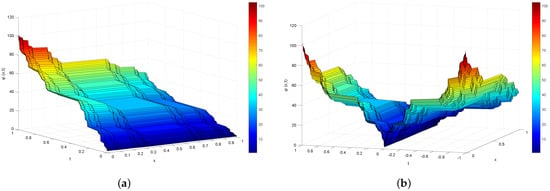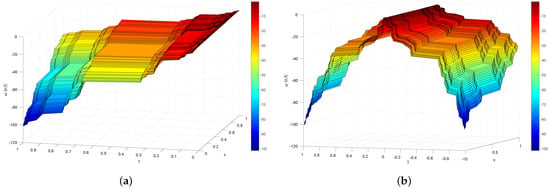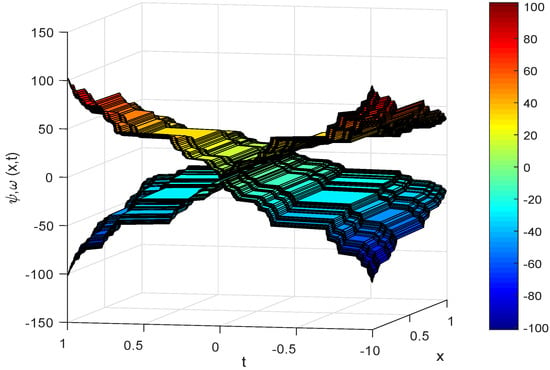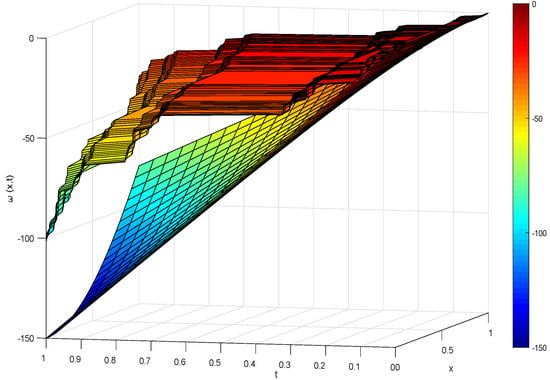Abstract
In this paper, the coupled local fractional sine-Gordon equations are studied in the range of local fractional derivative theory. The study of exact solutions of nonlinear coupled systems is of great significance for understanding complex physical phenomena in reality. The main method used in this paper is the local fractional homotopy perturbation method, which is used to analyze the exact traveling wave solutions of generalized nonlinear systems defined on the Cantor set in the fractal domain. The fractal wave with fractal dimension is numerically simulated. Through numerical simulation, we find that the obtained solutions are of great significance to explain some practical physical problems.
1. Introduction
In the field of science, most problems and phenomena are nonlinear, especially in mechanics [], plasma physics [], plasma waves, heat conduction [] and chemical physics. Many scholars have made accurate analysis of various nonlinear problems and put forward some methods to solve them. Examples include Backlund transformation [], bilinear method [], sine-cosine method [], Adomian decomposition method [], variational iteration method [], exp-function method [] and homotopy perturbation method (HPM) [,]. We conclude that HPM is the most effective and simplest method to solve nonlinear problems.
HPM was first proposed by He []. He introduced the HPM into the solution of nonlinear wave equations. The advantage of this method is that it does not depend on the small parameters in the topology. There is a homotopy technique in topology that we can use to construct a homotopy with one parameter, and it is considered to be a small parameter []. HPM is widely used in nonlinear wave equations. It is used to solve water wave theory [], heat conduction [] and diffusion problems [].
In recent years, Yang [] redefined and generalized the local order, and constructed a complete framework of the local order defined on Cantor sets. Local fractions are usually used to describe various fractal problems in real life and science. Local fraction theory is a new efficient algorithm to obtain the exact solution of a local fraction problem. The solution of this theory is defined on the Cantor set. Yang used the local fractional homotopy perturbation (LFHP) method to solve the wave equations involving Cantor sets []. Zhang used the same method to solve the heat conduction equation in the fractal system []. The results show that the theoretical method is accurate and feasible, and has strong practical significance.
A coupled system of nonlinear equations is as follows:
where are arbitrary constants, and .
The above coupled equations are an extension of the Frenkel–Kontorova model []. It simulates one-dimensional nonlinear wave processes in two-component media []. Coupled sine-Gordon equations with were proposed to describe the open states in a DNA model. The coupled sine-Gordon equations can describe the propagation of optical pulses in fiber waveguide []. It can also describe long wave motion in shallow water. In recent years, many scholars have studied and analyzed the system (1). Salas gives its exact soliton solution and periodic solution []. Zhao et al. obtained the exact solution of the above equation by using the hyperbolic auxiliary function method []. Hosseini et al. solved the above coupling equations in nonlinear optics by using an improved Kudryashov method [].
Our main purpose is to solve the traveling wave solutions of the following coupled local fractional sine-Gordon equations by using the LFHP method.
where is the fractal dimension and .
In this paper, the basic idea of the local fractional homotopy perturbation method is introduced and the traveling wave solutions of coupled local fractional sine-Gordon equations are obtained by using this method. The structure is as follows: The Section 2 introduces the basic theory and operation formula of local fractional calculus. The Section 3 introduces the basic idea and operation process of the LFHP method. In Section 4, we obtain the traveling wave solutions of coupled local fractional sinusoidal Gordon equations using the LFHP method, and obtain their wave images using MATLAB. Finally, we summarize the main conclusions in Section 5.
2. Local Fractional Calculus
2.1. Local Fractional Derivatives
Definition 1.
We define as a set of the nondifferentiable functions. Setting , local fractional derivative of of order at is defined by []
where .
In addition, the local higher order fractional partial derivative is defined as
The properties of the local fractional derivative are listed as follows []:
where , and .
2.2. Local Fractional Integral
Definition 2.
The local fraction integral of is defined as []
where , and with .
The properties of the local fractional integral are as follows:
2.3. Basic Operation
It defines the generalized function by []
Local fractional calculus has the following properties []
and
3. Local Fractional Homotopy Perturbation Method
For a given class of local fractional differential equations,
where is a local fractional differential operator.
First, let us set up a homotopy mapping []:
or
where is an imbedding parameter and is an initial approximation of Equation (5).
Let , then we can obtain, from Equation (6),
According to the homotopy perturbation theory, can be treated as a small parameter. Suppose that the solution of Equation (6) can be expressed as a power series of
Substituting Equation (9) into Equation (6), we obtain
An extended form of []
such that
which reduces to
and
Using the expression Equation (10), we find that
when , we have the approximate solution of the form:
4. Solution of System of Equations
In this section, the solutions of coupled local fractional sine-Gordon equations are discussed.
We consider the following system of local fractional equations:
In order to solve the coupled local part sine-Gordon equations, we can construct the following nondifferentiable homotopy:
Moreover,
Taking , then rearranging according to the power of -terms, we obtain:
When , the solutions of the coupled local fractional sine-Gordon equations are
When the fractal dimension is , the corresponding diagrams of and are as shown in Figure 1 and Figure 2.

Figure 1.
In the case of solution in the local fractional sine-Gordon equations, by choosing . (a) 0 ≤ t ≤ 1; (b) −1 ≤ t ≤ 1.

Figure 2.
In the case of solution in the local fractional sine-Gordon equations, by choosing . (a) 0 ≤ t ≤ 1; (b) −1 ≤ t ≤ 1.
The time-dependent behavior of and obtained from the theory of the local number order homotopy perturbation method is shown in Figure 3. We show the elastic interaction between two solitons. It can be seen that both solitons maintain their initial velocity and shape after interaction. In Figure 4, we compare the local motion diagram of the sine-Gordon equation with integer order and fractal dimension . Compared with the general homotopy perturbation method, the behavior graph obtained by this method is more realistic.

Figure 3.
In the case of local fractional sine-Gordon equations, by choosing parameters .

Figure 4.
Comparison of integer order and fractional dimension .
5. Conclusions
In this paper, we obtain the exact solution of a coupled local fractional sinusoidal Gordon equation by using the LFHP method, and show the special function graphs defined on the Cantor set when the fractal dimension is . The results show that the technique is effective in solving nonlinear partial order equations. The LFHP method solves many nonlinear problems in science and engineering. We consider that the LFHP method can theoretically solve the ac-driven sine-Gordon equation []. We will study it in future work. With the help of MATLAB and other mathematical software, this method provides a powerful mathematical tool for more complex nonlinear systems. In a word, the LFHP method provides highly accurate fractal solutions for nonlinear problems.
Author Contributions
Writing—original draft preparation and editing, L.C.; supervision, Q.L.; All authors have read and agreed to the published version of the manuscript.
Funding
This work was supported by the National Natural Science Foundation of China (Grant No.12062017), Program for Innovative Research Team in Universities of Inner Mongolia Autonomous Region, China (Grant No. NMGIRT2208) and the Natural Science Foundation of Inner Mongolia, China. (Grant No. 2022LHMS01001).
Data Availability Statement
Not applicable.
Conflicts of Interest
The authors declare no conflict of interest.
Abbreviations
In this part, the abbreviations used in our article are described below:
| HPM | homotopy perturbation method |
| LFHP | local fractional homotopy perturbation |
References
- Charpentier, I. On Higher-order Differentiation in Nonlinear Mechanics. Optim. Methods Softw. 2012, 27, 221–232. [Google Scholar] [CrossRef]
- Viana, R.L.; Silva, E.; Kroetz, T.; Caldas, I.T.; Roberto, M.; Sanjuan, A.F. Fractal Structures in Nonlinear Plasma Physics. Philos. Trans. R. Soc. A 2011, 369, 371–395. [Google Scholar] [CrossRef] [PubMed]
- Kalashnikov, A.S. The Propagation of Disturbances in Problem of Nonlinear Heat Conduction with Absorption. Comput. Math. Math. Phys. 1974, 14, 70–85. [Google Scholar] [CrossRef]
- Chowdhury, A.R.; Pal, S.K. N-fold Backlund Transformation for Deformed Nonlinear Schrödinger Equation. Int. J. Theor. Phys. 1997, 36, 1021–1031. [Google Scholar] [CrossRef]
- Liu, W.J.; Tian, B.; Zhang, H.Q.; Li, L.L.; Xue, Y.S. Soliton Interaction in the Higher-order Nonlinear Schrodinger equation Investigated with Hirota’s Bilinear Method. Phys. Rev. E 2008, 77, 066605. [Google Scholar] [CrossRef]
- Wazwaz, A.M. A Sine-cosine Method for Handling Nonlinear Wave Equations. Math. Comput. Model. 2004, 40, 499–508. [Google Scholar] [CrossRef]
- Ray, S.S.; Bera, R.K. An Approximate Solution of a Nonlinear Fractional Differential Equation by Adomian Decomposition Method. Appli. Math. Comp. 2005, 167, 561–571. [Google Scholar]
- Askari, H.; Zhang, D.; Esmailzadeh, E. Periodic Solutions for Nonlinear Oscillations of Nanowires Using Variational Iteration Method. In Proceedings of the 2013 13th IEEE International Conference on Nanotechnology (IEEE-NANO 2013), Beijing, China, 5–8 August 2013. [Google Scholar]
- Wu, X.H.; He, J.H. EXP-function Method and its Application to Nonlinear Equations. Chaos Solitons Fractals 2008, 38, 903–910. [Google Scholar]
- Rajabi, A.; Ganji, D.D.; Taherian, H. Application of Homotopy Perturbation Method in Nonlinear Heat Conduction and Convection Equations. Phys. Lett. 2007, 360, 570–573. [Google Scholar] [CrossRef]
- Asllanaj, F.; Jeandel, G.; Roche, J.R. Numerical Solution of Radiative Transfer Equation Coupled with Nonlinear Heat Conduction Equation. Int. J. Numer. Methods Heat Fluid Flow 2015, 11, 449–473. [Google Scholar] [CrossRef]
- He, J.H. Application of Homotopy Perturbation Method to Nonlinear Wave Equations. Chaos Solitons Fractals 2005, 26, 695–700. [Google Scholar] [CrossRef]
- Ganji, D.D.; Sadighi, A.; Ganjavi, B. Traveling Wave Solutions of the Sine-gordon and the Coupled Sine-gordon Equations Using the Homotopy-perturbation Method. Sci. Iran. 2009, 16, 189–195. [Google Scholar]
- Mustafa Inc. He’s Homotopy Perturbation Method for Solving Korteweg-de Vries Burgers Equation with Initial Condition. Numer. Methods Partial. Differ. Equ. 2010, 26, 1224–1235. [Google Scholar]
- Ganji, D.D. The Application of He’s Homotopy Perturbation Method to Nonlinear Equations Arising in Heat Transfer-Science Direct. Phys. Lett. A 2006, 355, 337–341. [Google Scholar] [CrossRef]
- Ganji, D.D.; Sadighi, A. Application of He’s Homotopy-perturbation Method to Nonlinear Coupled Systems of Reaction-diffusion Equations. Int. J. Nonlinear Sci. Num. Simul. 2006, 7, 411–418. [Google Scholar] [CrossRef]
- Yang, X.J. Advanced Local Fractional Calculus and Its Applications; Orld Science: New York, NY, USA, 2012. [Google Scholar]
- Yang, X.J.; Srivastava, H.M.; Cattani, C. Local Fractional Homotopy Perturbation Method for Solving Fractal Partial Differential Equation Arising in Mathematical Physics. Rom. Rep. Phys. 2015, 67, 752–761. [Google Scholar]
- Zhang, Y.; Carlo, C. and Yang, X.J. Local Fractional Homotopy Perturbation Method for Solving Non-Homogeneous Heat Conduction Equations in Fractal Domains. Entropy 2015, 17, 6753–6764. [Google Scholar] [CrossRef]
- Braun, O.M.; Kivshar, Y.S. Nonlinear Dynamics of the Frenkel-Kontorova Model with Impurities. Phys. Rev. B Condens Matter 1998, 306, 1060–1073. [Google Scholar] [CrossRef]
- Saha, S.; Ray. A Numerical Solution of the Coupled Sine-Gordon Equation Using the Modified Decomposition Method. Appl. Math. Comput. 2006, 175, 1046–1054. [Google Scholar]
- Hosseini, K.; Mayeli, P.; Kumar, D. New exact solutions of the coupled sine-Gordon equations in nonlinear optics using the modified Kudryashov method. J. Mod. Opt. 2017, 65, 361–364. [Google Scholar] [CrossRef]
- Salas, A.H. Exact Solutions of Coupled Sine-Gordon Equations. Nonlinear Anal.-Real 2010, 11, 3930–3935. [Google Scholar] [CrossRef]
- Zhao, Y.M.; Liu, H.H.; Yang, Y.J. Exact Solutions for the Coupled Sine-Gordon Equations by a New Hyperbolic Auxiliary Function Method. Appl. Math. Sci. 2011, 5, 1621–1629. [Google Scholar]
- Yang, X.J.; Machado, J.A.T.; Hristov, J. Nonlinear Dynamics for Local Fractional Burgers’ equation Arising in Fractal Flow. Nonlinear Dyn. 2016, 84, 3–7. [Google Scholar] [CrossRef]
- Ghanbari, B. On Novel Nondifferentiable Exact Solutions to Local Fractional Gardner’s Equation Using an Effective Technique. Math. Method Appl. Sci. 2021, 44, 4673–4685. [Google Scholar] [CrossRef]
- Yang, X.J.; Machado, J.T.; Baleanu, D.; Cattani, C. On Exact Traveling-wave Solutions for Local Fractional Korteweg-de Vries Equation. Chaos 2016, 26, 110–118. [Google Scholar] [CrossRef]
- Yang, X.J. Local Fractional Integral Transforms and Their Applications; Academic Press: Cambridge, MA, USA, 1995. [Google Scholar]
- Quintero, R.N.; Sánchez, A. Ac driven sine-Gordon solitons: Dynamics and stability. Eur. Phys. J. B 1998, 6, 133–142. [Google Scholar] [CrossRef][Green Version]
Publisher’s Note: MDPI stays neutral with regard to jurisdictional claims in published maps and institutional affiliations. |
© 2022 by the authors. Licensee MDPI, Basel, Switzerland. This article is an open access article distributed under the terms and conditions of the Creative Commons Attribution (CC BY) license (https://creativecommons.org/licenses/by/4.0/).